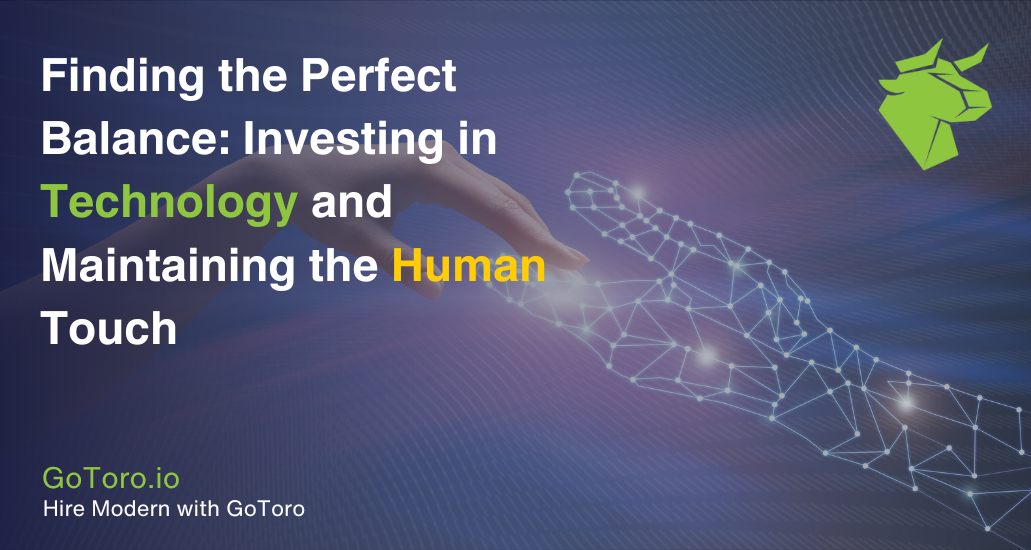The Growing Role of Technology in Recruitment

In today’s rapidly evolving job market, technology has become an indispensable tool in recruitment. From streamlining processes to improving candidate matching, the integration of advanced tech solutions has revolutionized the way companies hire. However, while these innovations offer significant advantages, balancing technology with personal interaction is crucial to creating a positive candidate experience.
Balancing technology in recruitment is not just about adopting the latest tools; it’s about using them in a way that complements the human touch. Candidates still value personalized communication and the empathy that only human recruiters can provide. As companies continue to invest in automation, finding the right balance between efficiency and personalization is essential to maintaining a competitive edge in talent acquisition.
The Role of Technology in Modern Recruitment
Automation Tools: Enhancing Efficiency While Balancing Technology with Human Interaction
Automation has become a cornerstone of modern recruitment, offering tools that can handle repetitive tasks with precision and speed. AI-driven applicant tracking systems (ATS) are now commonplace, helping recruiters sort through vast amounts of applications in a fraction of the time it would take manually. These systems can automatically screen resumes, rank candidates based on predetermined criteria, and even schedule interviews.
Chatbots have also gained traction as a means of initial candidate interaction. These AI-powered assistants can answer common questions, guide applicants through the application process, and collect preliminary information. While these tools are invaluable for efficiency, it’s important to remember that balancing technology with the human touch ensures candidates don’t feel alienated by an overly automated process.
Data Analytics: Balancing Technology to Drive Data-Driven Recruitment Strategies
Data analytics has transformed recruitment from a process often driven by intuition to one grounded in actionable insights. By analyzing vast amounts of data, companies can identify trends, measure the effectiveness of recruitment campaigns, and optimize their strategies accordingly. Tools that provide data-driven insights enable recruiters to make more informed decisions, from where to post job ads to how to structure interviews.
However, in balancing technology with human insight, it’s essential to ensure that data does not overshadow the individual nuances of each candidate. While analytics can highlight patterns and predict outcomes, the final decision-making process should still involve a human touch to account for factors that data alone cannot capture.
Virtual Interviews: Balancing Technology with Personal Connection
The rise of video interviewing platforms has revolutionized the interview process, especially in a world where remote work has become more prevalent. Virtual interviews offer convenience and flexibility for both candidates and employers, allowing for a broader talent pool that is not restricted by geographical boundaries.
While the efficiency of virtual interviews is undeniable, balancing technology with personal connection is key. It’s important to ensure that these digital interactions don’t feel impersonal. Recruiters should focus on creating a warm and engaging environment, even through a screen, to maintain the human element in the hiring process. Techniques such as personalized questions, active listening, and ensuring the technology is user-friendly can help bridge the gap between virtual and in-person interactions.
Benefits of Investing in Recruitment Technology

Efficiency and Speed: Balancing Technology for Accelerated Hiring Processes
One of the most significant advantages of investing in recruitment technology is the boost in efficiency and speed it provides. Automation tools, such as AI-driven applicant tracking systems (ATS), streamline tasks that would traditionally require significant time and effort. These systems can sort resumes, rank candidates, and even conduct preliminary assessments, all within minutes. By reducing manual tasks, recruiters can focus their time on more strategic aspects of hiring, such as engaging with top candidates and refining their recruitment strategies.
Balancing technology in this context means leveraging these tools to handle repetitive tasks while ensuring that the personal touch is not lost. By automating the basics, recruiters can provide a more tailored experience during the later stages of the hiring process, where human interaction is most impactful.
Scalability: Balancing Technology to Handle Large Volumes Without Compromising Quality
As companies grow, the need to scale recruitment efforts becomes increasingly important. Recruitment technology enables organizations to manage large volumes of applications efficiently, ensuring that no potential candidate is overlooked. With the right tools, companies can maintain high standards in their recruitment processes, even when dealing with a surge in applications.
Balancing technology here involves using automated systems to handle the volume while ensuring that the quality of candidate assessments remains high. This balance allows companies to grow without compromising the integrity of their hiring process, ultimately leading to better hires and a stronger workforce.
Improved Candidate Matching: Balancing Technology for More Accurate Hiring Decisions
AI tools are revolutionizing candidate matching by analyzing data points beyond what human recruiters can easily process. These tools can assess skills, experience, and even cultural fit with remarkable accuracy, leading to better matches between candidates and job roles. This results in not only a more efficient hiring process but also improved long-term retention rates.
However, balancing technology with human insight is crucial. While AI can provide a list of candidates who match the technical criteria, the final decision should involve a human recruiter who can consider the less tangible qualities that technology might overlook. This combination ensures that companies make well-rounded hiring decisions that benefit both the organization and the candidate.
Maintaining the Human Touch

Personalized Communication: Balancing Technology with Human Interaction
In the age of automation, personalized communication remains a key factor in successful recruitment. Candidates appreciate the effort taken to send personalized emails, make phone calls, and conduct face-to-face interactions. These gestures go a long way in building strong relationships and ensuring candidates feel valued throughout the hiring process.
Balancing technology with personalized communication means using automated tools to gather data and insights that enable more meaningful interactions. For instance, technology can track candidate preferences and past interactions, allowing recruiters to tailor their communication and make every interaction count.
Candidate Experience: Balancing Technology to Enhance the Overall Candidate Journey
The candidate experience is a critical component of any recruitment process, and maintaining a positive experience is essential for a company’s reputation. While technology can streamline and enhance many aspects of recruitment, it’s the human touch that often makes the most significant impact on candidates.
Balancing technology with a focus on candidate experience involves using tools to simplify the application process, provide timely updates, and offer a seamless interview experience. At the same time, recruiters should ensure that candidates receive personalized attention, feel heard, and have their unique needs addressed. This balance leads to a more positive impression of the company and can significantly improve the chances of securing top talent.
Empathy in Recruitment: Balancing Technology with Compassionate Candidate Engagement
Empathy is a cornerstone of effective recruitment, and it’s something that technology alone cannot replicate. Recruiters play a vital role in providing support, guidance, and understanding throughout the hiring process, helping candidates navigate the often stressful experience of job searching.
Balancing technology with empathy involves using automated tools to handle logistical aspects of recruitment while ensuring that human recruiters are available to provide the emotional and professional support candidates need. By doing so, companies can foster a recruitment process that is both efficient and compassionate, ultimately leading to better outcomes for all parties involved.
Strategies for Balancing Technology and Human Interaction

Selective Automation: Balancing Technology Without Sacrificing Engagement
When it comes to balancing technology and human interaction in recruitment, selective automation is key. Not every aspect of the recruitment process needs to be automated. Identifying which tasks can be efficiently handled by technology—such as resume screening, interview scheduling, and initial candidate outreach—without losing the personal touch is crucial.
By balancing technology in this way, companies can automate repetitive and time-consuming tasks while reserving personal engagement for the most critical stages of the hiring process. This approach ensures that automation enhances, rather than detracts from, the overall candidate experience.
Tech-Enhanced Human Interaction: Balancing Technology to Empower Recruiters
Balancing technology with human interaction doesn’t mean choosing one over the other; it’s about integrating them in a way that makes each more effective. Technology can be used to empower recruiters by providing them with insights and data that inform better, more personalized interactions with candidates.
For example, AI can analyze candidate data to highlight key skills, experiences, and preferences, allowing recruiters to tailor their conversations and build stronger relationships. This tech-enhanced human interaction ensures that recruiters have the tools they need to engage with candidates meaningfully, making the recruitment process more efficient and effective.
Continuous Feedback Loop: Balancing Technology and Human Touch for Ongoing Communication
A successful recruitment process relies on continuous communication and feedback between candidates and recruiters. Balancing technology with a human touch in this context means using digital tools to support, not replace, ongoing interactions.
Automated systems can provide timely updates on application status, while human recruiters can step in to offer personalized feedback and address candidate concerns. This continuous feedback loop ensures that candidates remain engaged and informed throughout the process, ultimately leading to a more positive experience and better hiring outcomes.
Evaluating the ROI of Technology Investments
Aligning Tech Investments with Business Goals: Balancing Technology for Strategic Recruitment
Before investing in new recruitment technology, it’s essential to assess whether these tools align with the company’s broader business goals. Balancing technology with strategic intent ensures that any investment made will contribute to the overall success of the recruitment process.
Companies should consider how a particular technology solution fits within their recruitment strategy and whether it addresses their specific pain points. By aligning tech investments with business goals, organizations can ensure they achieve a high return on investment and enhance their recruitment outcomes.
Measuring Success: KPIs for Balancing Technology Effectiveness
To determine the effectiveness of technology in recruitment, it’s important to establish key performance indicators (KPIs) that reflect both efficiency and quality. These KPIs might include metrics such as time-to-hire, candidate satisfaction, and cost-per-hire. Balancing technology in this context means using these metrics to evaluate whether the technology is delivering the expected benefits without compromising the human element of recruitment.
By regularly measuring these KPIs, companies can make informed decisions about their technology investments, ensuring that they continue to add value to the recruitment process while maintaining the necessary human touch.
As the recruitment landscape continues to evolve, finding the right balance between technology and the human touch has never been more crucial. Balancing technology with personal engagement allows companies to leverage the efficiencies and scalability that modern tools offer while preserving the empathy and connection that only human recruiters can provide. This equilibrium is key to creating a recruitment process that is not only efficient but also engaging and satisfying for candidates.
By carefully selecting which parts of the recruitment process to automate, and using technology to enhance rather than replace human interaction, companies can optimize their recruitment strategies. This balanced approach leads to better hiring outcomes, improved candidate experiences, and ultimately, a more successful recruitment process.
Achieving Balance for Enhanced Efficiency and Satisfaction
To achieve this balance, companies must take a strategic approach to technology investments. It’s essential to ensure that any technological tools align with broader business goals and enhance, rather than detract from, the recruitment process. Regularly measuring the impact of these tools through key performance indicators (KPIs) can help maintain this balance, ensuring that the benefits of technology are realized without losing the personal touch that candidates value.
Balancing technology effectively can lead to a more efficient hiring process, higher candidate satisfaction, and better overall recruitment outcomes. By keeping the human element at the core of their recruitment strategy, companies can differentiate themselves in a competitive job market.
Ready to take your recruitment process to the next level? Discover how GoToro can help you achieve the perfect balance between technology and human interaction. Request a demo today to see how our innovative solutions can enhance your recruitment efficiency and boost candidate satisfaction.


